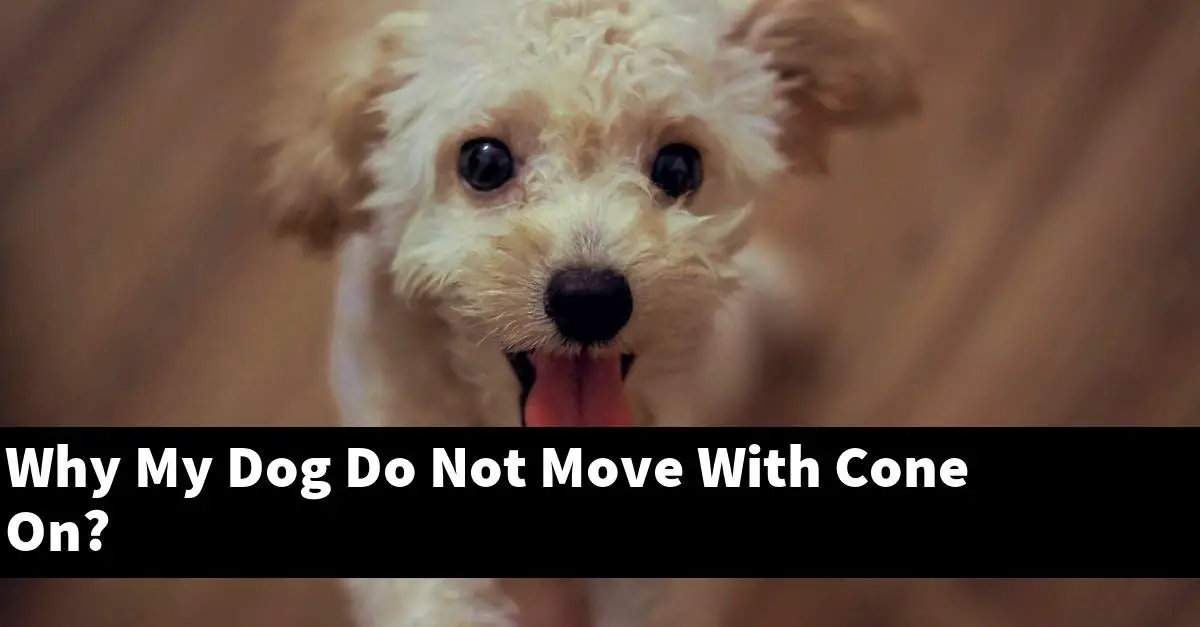Why is my dog not moving with the cone on?
The cone is necessary to prevent your dog from licking or scratching the area where they have had surgery. The Elizabethan collar is also called an “e-collar” or “cone” and is used to prevent animals from licking or scratching wounds.
The article is going to be discussing why dogs do not like to move with a cone on their head.
Table of Contents
What is the reason your dog does not move with a cone on?
There are several reasons your dog may not be moving well with a cone on. One reason may be that the cone is too tight and is causing your dog discomfort. Another reason may be that your dog is not used to the cone and is feeling insecure.
If your dog is used to being active, the cone may also be preventing him from moving as he normally would.
How can you help your dog feel more comfortable with a cone on?
If your dog has been fitted with a cone to prevent them from licking or scratching a wound, there are a few things you can do to help make them more comfortable.
- Firstly, it is important to get your dog used to the cone gradually. Start by letting them wear it for short periods of time, gradually increasing the duration each day. If your dog seems distressed, try placing a treat or toy inside the cone to distract them.
- Secondly, make sure your dog has plenty of space to move around freely while wearing the cone. If they are constantly bumping into things or getting caught on things, this will only aggravate them further.
- Finally, keep an eye on your dog’s skin and fur condition while they are wearing the cone. If the cone is rubbing against their skin, causing irritation, you may need to adjust it or get a different size.
Should you let your dog sleep with a cone on?
It’s common for dogs to wear a cone after surgery to prevent them from licking their stitches, but is it really necessary? The answer may surprise you.
There are pros and cons to letting your dog sleep with a cone on. On the one hand, it can help prevent your dog from licking their stitches and causing an infection. On the other hand, it can be uncomfortable for your dog and make it difficult for them to sleep.
ultimately, the decision of whether or not to let your dog sleep with a cone on is up to you and your veterinarian. If you’re worried about your dog licking their stitches, talk to your vet about other options, such as an Elizabethan collar.
Should I take my dog’s cone off at night?
If your dog is recovering from an injury or surgery, your veterinarian may have prescribed the use of an Elizabethan collar, also called an “e-collar” or “cone.” The cone prevents your dog from licking or scratching at his wound, which is important for healing. But you may be wondering if you should take the cone off at night.
Here’s what you need to know:
- The cone should only be removed when your dog is supervised.
- If your dog is licking or scratching at his wound, the cone should be left on.
- Remove the cone when your dog is eating, drinking, or playing.
- Put the cone back on after your dog is finished with his activities.
- If your dog is comfortable and not licking or scratching at his wound, you may be able to leave the cone off for short periods of time.
The bottom line is that you should follow your veterinarian’s instructions when it comes to the use of an Elizabethan collar. If you have any questions or concerns, be sure to give your vet a call.
How long does it take for a dog to adjust to a cone?
Most dogs will take a few days to adjust to wearing a cone. The cone may make them feel a little awkward at first and they may bump into things, but they’ll quickly learn to maneuver with it. If your dog seems to be having a lot of trouble or is getting frustrated, you can try putting the cone on for short periods of time throughout the day. This will help them get used to it gradually.
Why does my dog not move with a cone on?
Many people don’t realize that their dog’s cone is actually causing them a lot of discomforts. The cone prevents your dog from being able to move their head around freely, which can make it difficult for them to balance. Additionally, the cone can rub against your dog’s skin, causing irritation.
Why does a dog freeze?
There are several reasons why a dog may freeze, including:
- Fear: A dog may freeze if it is scared or feels threatened. This is often seen in dogs that are afraid of loud noises or unfamiliar people or animals.
- Pain: A dog may also freeze if it is in pain. This may be due to an injury or illness.
- Discomfort: A dog may freeze if it is uncomfortable, such as when it is cold or hot.
- Boredom: A dog may also freeze out of boredom. This is often seen in dogs that are left alone for long periods of time with nothing to do.
- Confusion: A dog may freeze if it is confused or does not understand what is happening. This may be due to a change in environment or routine, or due to a traumatic event.
Should I take my dog’s collar off at night in crate?
The answer to this question depends on a few factors. If your dog is comfortable wearing a collar and you feel that it does not pose a risk of getting caught or tangled, then there is no need to remove it. However, if you are concerned about your dog getting tangled or caught, then it is best to remove the collar before putting your dog in the crate.
Why do dogs freeze with a cone?
There are a few reasons why dogs may freeze when they have a cone around their neck. The first reason is that they may be feeling uncomfortable or constricted. The cone can make it difficult for them to move their head and neck, which can be unsettling. Additionally, the cone may be blocking their vision, making them feel disoriented.
Another possibility is that the dog is experiencing pain. The cone may be rubbing against their skin, or they may have an injury that is aggravated by the cone. If your dog seems to be in pain, it is best to consult with your veterinarian.
Finally, some dogs simply do not like the cone. It is new and unfamiliar, and they may be hesitant to move around with it on. If your dog is resistant to the cone, you may want to try acclimating them to it by putting it on for short periods of time at first. With patience and positive reinforcement, most dogs will eventually get used to the cone.
How do I get my dog to walk with a cone on?
If your dog is recovering from an injury or surgery, they may need to wear a cone (or “e-collar”) to prevent them from licking or scratching the area. Getting your dog used to wearing a cone can take some time and patience, but with a little effort, you can help make the experience more positive for both of you.
Here are a few tips to get started:
- Start by getting your dog used to the cone itself. Let them sniff and investigate it before putting it on.
- Put the cone on for short periods of time at first, gradually increasing the amount of time they wear it.
- Be sure to praise and treat your dog when they are wearing the cone, to help create a positive association.
- Keep mealtimes and other favorite activities around the cone, so your dog learns that good things happen when they wear it.
- Avoid putting the cone on when your dog is already feeling anxious or stressed, as this can make the experience more negative.
With a little patience and positive reinforcement, most dogs can learn to accept wearing a cone. If you’re having difficulty, or if your dog seems to be in distress, please consult with your veterinarian for additional help and guidance.
Conclusion
There are a number of reasons why your dog may not want to move with a cone on. The cone may be uncomfortable or it may be difficult for your dog to see. Additionally, your dog may be used to having a lot of freedom and may not want to be restricted.
If your dog is having trouble adjusting to the cone, try to make the experience as positive as possible. Give your dog treats and plenty of praise when he or she does something good. With time and patience, your dog will learn to accept the cone.


